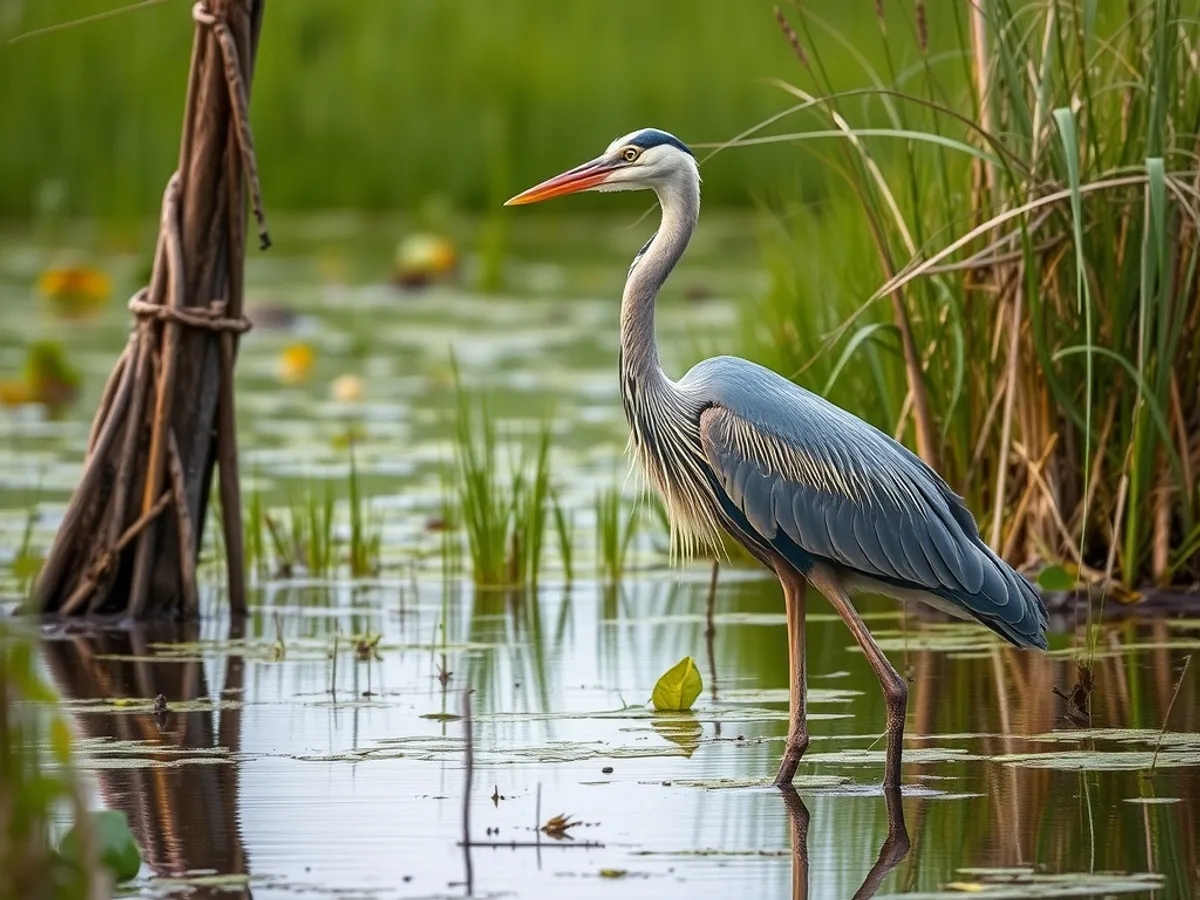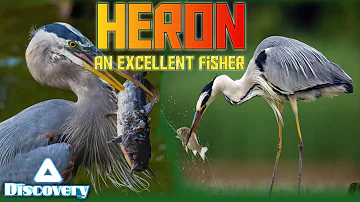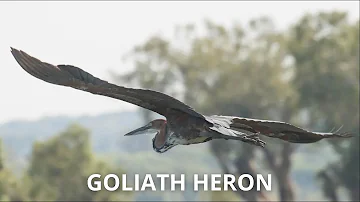
Goliath Heron
Ardea goliath

Meet the Goliath Heron
The Goliath Heron is the world's largest heron, standing up to 1.5 meters (nearly 5 feet) tall with a striking rufous chestnut head and neck. This imposing bird is found primarily in sub-Saharan Africa, often seen stalking the shallow waters of lakes, rivers, and swamps. Its massive bill is perfectly adapted for catching large fish, its main food source. With slow, deliberate movements, the Goliath Heron is known for its patience and precision as a hunter.
Classification
Bird
Habitat
Freshwater wetlands
Diet
Carnivore
Lifespan
12-15 years
Conservation
Least Concern
Weight
4-5 kg
📖Fascinating Facts
World's Largest Heron
The Goliath Heron stands up to 1.5 meters tall and has a wingspan reaching 2.3 meters, making it the largest of all heron species.
Fish Specialist
Its diet consists almost exclusively of fish, which it hunts with remarkable patience, often standing still for long periods before striking.
Wide African Range
Though mainly found in sub-Saharan Africa, the Goliath Heron also occurs in parts of the Middle East and occasionally South and Southeast Asia.
📋Detailed Description
The Goliath Heron (Ardea goliath) is the largest living heron, with adults typically standing 120–152 cm (3.9–5.0 ft) tall and weighing between 4–5 kg (8.8–11 lbs). Its wingspan can reach up to 230 cm (7.5 ft), making it a truly imposing presence in its wetland habitats. The plumage is distinctive: the head, neck, and chest are a rich rufous-chestnut, while the upperparts are slate-gray, and the underparts are paler with streaks. The bill is massive, dagger-like, and dark, perfectly adapted for spearing large prey. The legs are long and blackish, with large feet suited for wading in soft substrates. Goliath Herons are solitary and territorial, often occupying large stretches of shoreline or reedbeds. Their deep, booming calls can carry over long distances, especially during the breeding season. Their flight is slow and ponderous, with deep wingbeats and legs trailing straight behind. The species is highly aquatic, rarely venturing far from water, and is most active during early morning and late afternoon. Juveniles resemble adults but are duller and browner, lacking the full intensity of adult coloration.
💡 Did you know?
The Goliath Heron can catch and swallow fish up to 1 kg (2.2 lbs) in weight—sometimes nearly a quarter of its own body mass!
🔬Research & Sources
Wikipedia Summary
The Goliath heron, also known as the giant heron, is a very large wading bird of the heron family, Ardeidae. It is found in sub-Saharan Africa, with smaller, declining numbers in Southwest and South Asia.
Last Modified: 2/25/2025
🎭Behavior & Social Structure
Goliath Herons are solitary hunters, rarely tolerating other herons within their feeding territories. They exhibit a 'stand-and-wait' hunting strategy, often remaining motionless for extended periods before striking rapidly at passing fish. Their diet consists mainly of large fish, often weighing 500–1000 g (1.1–2.2 lbs), but they may also consume amphibians, small reptiles, and occasionally aquatic invertebrates. They are diurnal, with peak activity at dawn and dusk, and spend much of the day roosting or preening. Social interactions are limited outside the breeding season, though loose aggregations may occur in areas of abundant food. Aggressive displays, such as bill stabbing and wing spreading, are used to defend territories. Vocalizations include deep, resonant 'krooom' calls, especially at nest sites or when alarmed.
👶Reproduction & Life Cycle
Breeding occurs during the local rainy season, varying regionally across its range. Goliath Herons are monogamous within a breeding season, with pairs forming strong bonds. Nests are large platforms of sticks, reeds, and other vegetation, typically built in trees, reedbeds, or on islands, often over water to deter predators. Clutch size is usually 2–4 pale blue-green eggs. Both parents share incubation duties, which last about 24–30 days. Chicks are semi-altricial, hatching with sparse down and requiring extensive parental care. Both adults feed the chicks by regurgitation. Fledging occurs at 5–6 weeks, but young may remain dependent on parents for several weeks after leaving the nest. Breeding success is often limited by predation and flooding of nest sites.
🛡️Adaptations & Survival
The Goliath Heron's large size and powerful bill are evolutionary adaptations for subduing and handling large, slippery fish. Its long legs and toes distribute weight, allowing it to wade in deep or soft-bottomed wetlands without sinking. The cryptic coloration provides camouflage among reeds and aquatic vegetation. Behavioral adaptations include extreme patience and slow, deliberate movements to avoid startling prey. The species' deep, resonant calls are adapted for long-distance communication in dense wetland environments. Its preference for isolated, undisturbed habitats reduces competition with smaller heron species.
🎨Cultural Significance
The Goliath Heron is occasionally featured in African folklore and traditional stories, often symbolizing patience, vigilance, or the spirit of water. In some cultures, herons are considered omens or messengers. However, the Goliath Heron itself is not widely hunted or used in traditional medicine, likely due to its rarity and the inaccessibility of its preferred habitats. Its impressive size and striking appearance make it a sought-after species for birdwatchers and ecotourism.
🔬Recent Research & Discoveries
Recent research has focused on the species' ecological requirements, breeding biology, and responses to habitat alteration. Studies using satellite telemetry have begun to reveal movement patterns and habitat use, highlighting the importance of large, undisturbed wetlands. Ongoing monitoring in East and Southern Africa is tracking population trends and the impacts of climate variability. There is growing interest in the role of Goliath Herons as indicators of wetland health. Genetic studies are limited but suggest low genetic diversity in some isolated populations, warranting further investigation.
🎥Wildlife Videos

An Epic Clash of Titans: Goliath Heron vs African Fish Eagle | Kruger National Park #safari #birds
Prepare for a wildlife spectacle as we witness a gripping battle unfold between two formidable predators of the African wilderness.
Georgina May Judd

HERON - Are Excellent Fishers | Wildlife Documentary , Animal fact Discover | Animal Discover |
The heron is long-legged, long-necked, freshwater and coastal birds. They belong to the Ardeidae family, with 64 observed ...
Animal Discovery

NILE RIVER | Survival Tales in Africa's Lifeline #naturedocumentaries | Wild Nature
NILE RIVER | Survival Tales in Africa's Lifeline #naturedocumentaries | Wild Nature Welcome to the channel! Today, we're ...
WILD NATURE - Nature animal documentary

Animal Wildlife | goliath heron
Animals channel: Welcome to the world of wildlife photography! Our channel showcases stunning moments of animals in ...
Animals

June 7 2022: Goliath (giant) heron lands at Olifants River, turns around, ruffles it’s feathers
goliathheron #giantheron.
afarTV

Malama & Goliath Heron
Malama finds a dead goliath heron and investigates!
Flatdogs Camp
🌍Habitat Information
The Goliath Heron typically inhabits Freshwater wetlands environments. Goliath Herons have adapted to their environments with specialized features and behaviors.
Primary Habitat:
Freshwater wetlands
More detailed habitat information will be available soon.
🛡️Conservation Status
The Goliath Heron is currently classified as Least Concern. Conservation efforts are crucial for preserving this species for future generations.
Common Threats:
- 🏠Habitat loss and fragmentation
- 🌡️Climate change impacts
- 🎯Hunting and poaching
- 🏭Human-wildlife conflict
⚠️Threats & Conservation Challenges
While globally listed as Least Concern, the Goliath Heron faces localized threats including wetland drainage, habitat degradation, pollution, and disturbance from human activity. Overfishing and competition for fish stocks can reduce food availability. In some regions, eggs and chicks are vulnerable to predation by monitor lizards, snakes, and birds of prey. Population declines have been noted in parts of South and Southwest Asia, where the species is now rare or extirpated. Climate change and increasing droughts pose emerging threats to wetland habitats. Conservation challenges include protecting large, undisturbed wetlands and mitigating human disturbance.
🔬Scientific Classification
Scientific Name
Ardea goliath
Classification Hierarchy
🔍 About Taxonomic Classification
Taxonomic classification is a hierarchical system used by scientists to classify and organize living organisms based on shared characteristics and evolutionary relationships.
The system moves from broad categories (Kingdom) to increasingly specific ones, with each animal's scientific name typically consisting of its Genus and species.
📝Community Notes
Share your observations and insights about the Goliath Heron with our community of wildlife enthusiasts.
Join Our Community
Sign in to share your observations and connect with fellow wildlife enthusiasts.
Sign In to ContributeNo community notes yet
Be the first to share your observations about the Goliath Heron!
Explore Goliath Heron
Select a tab above to learn more about this amazing animal.
📸Photo Gallery
No photos available for this animal yet.
🌟Discover More Wildlife
Continue your journey of discovery with more fascinating animals from our database
